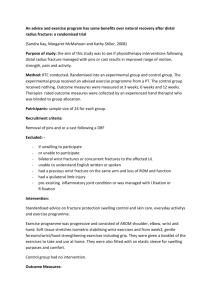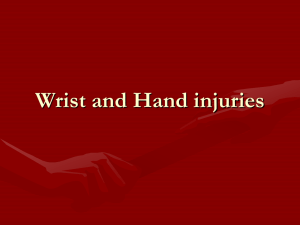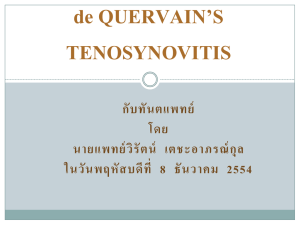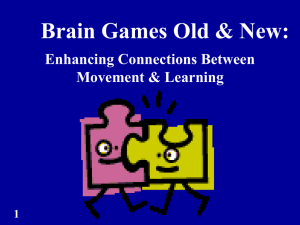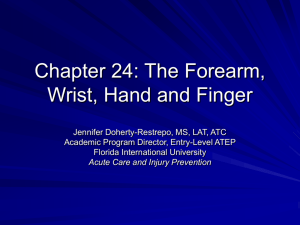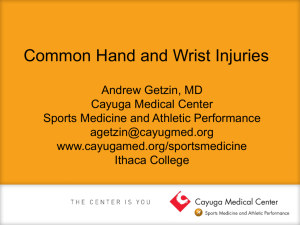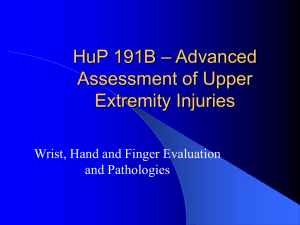Chapter Twentyfour
advertisement
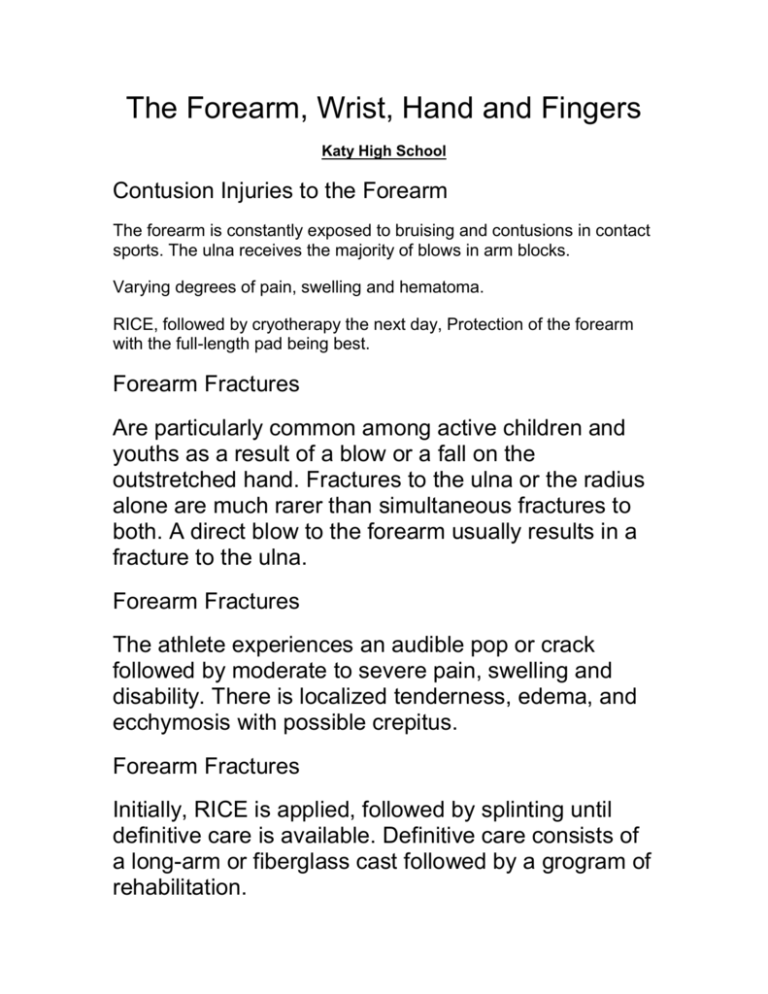
The Forearm, Wrist, Hand and Fingers Katy High School Contusion Injuries to the Forearm The forearm is constantly exposed to bruising and contusions in contact sports. The ulna receives the majority of blows in arm blocks. Varying degrees of pain, swelling and hematoma. RICE, followed by cryotherapy the next day, Protection of the forearm with the full-length pad being best. Forearm Fractures Are particularly common among active children and youths as a result of a blow or a fall on the outstretched hand. Fractures to the ulna or the radius alone are much rarer than simultaneous fractures to both. A direct blow to the forearm usually results in a fracture to the ulna. Forearm Fractures The athlete experiences an audible pop or crack followed by moderate to severe pain, swelling and disability. There is localized tenderness, edema, and ecchymosis with possible crepitus. Forearm Fractures Initially, RICE is applied, followed by splinting until definitive care is available. Definitive care consists of a long-arm or fiberglass cast followed by a grogram of rehabilitation. Wrist Sprains A sprain is the most common injury to the wrist, and in most cases, the most poorly managed injury in sports. Falling on the hyperextended wrist is th emost common cause of wrist sprains, but a violent flexion or torsion will also tear supporting tissue. Wrist Sprains Complains of pain, swelling, and difficulty moving the wrist. There is tenderness, swelling and limited ROM upon examination. Refer to physician for x-rays to rule out fracture Treat with RICE, splinting and analgesics. Start hand strengthening exercises and tape for support. Scaphoid Fracture Is the most frequently fractured bone of the carpal bones. Usually caused by a force on the outstretched hand which compresses the scaphoid bone between the radius and the second row of carpal bones. Very often thought to be a sprained wrist and so complete immobilization is not performed. Scaphoid Fracture The signs of a recent scaphiod fracture include swelling in the area of the carpal bones, severe tenderness of the scaphoid bone in the anatomical snuffbox, and scaphoid pain that is elicited by upward pressure exerted on the long axis of the thumb and by radial flexion. Scaphoid Fracture Treatment includes referral to the physician or x-ray study and casting. Surgery may need to be performed if the bone does not heal without fixation. Mallet Finger Common in sports, is sometimes called baseball finger or basketball finger. It is caused by a blow from a thrown ball that strikes the tip of the finger, jamming and avulsing the extensor tendon from its insertion along with a piece of bone. Mallet Finger RICE is given for the pain and swelling. If there is no fracture, the distal phalanx should be immediately splinted in position of extension for a period of 6 to 8 weeks. Boutonniere Deformity The boutonniere, or buttonhole deformity is caused by a rupture of the extensor tendon dorsal to the middle phalanx. Trauma occurs to the tip of the finger, which forces the DIP joint into extension and the PIP joint into flexion. Boutonniere Deformity Signs include severe pain and inability to extend the DIP joint. There is swelling, joint tenderness and an obvious deformity. Management include cold application followed by splinting for 5 to 8 weeks. While the finger is splinted, the athlete is encouraged to flex the distal phalanx. Gamekeeper’s Thumb A sprain to the ulnar collateral ligament of the MCP joint of the thumb. Common to athletes. Signs include pain over the ulnar collateral ligament in addition to a weak and painful pinch. Tenderness and swelling over the medial aspect of the thumb. Gamekeeper’s Thumb Management includes referral to physician if there is instability in the joint. If the joint is stable, x-ray to rule out fracture. Splint thumb for protection for 3 weeks or until the thumb is pain free. Taping should continue throughout the season. Sprains to Fingers Common in sports. Can range from minor to complete tear of collateral ligaments. Usually caused by axial force that produces a jammed finger. This mechanism places valgus or varus stress on the interphalangeal joint. Sprains to Fingers Complaints of pain and swelling at the involved joint. There is severe point tenderness at the joint site, especially at the region of the joint site. Management includes RICE for the acute stage, XRay to rule out fracture, and splinting. Taping when returning to activity will help. Dislocations Have a high incidence in athletics. Can occur to either the PIP of DIP joints. DO NOT reduce, send to physician for X-Ray and reduction. RICE, especially elevation while taking to physician. Once reduce, if not fractured, then you have a sprained finger. Rehabilitation of Injuries The following are REHABILITATION exercises and not MANAGEMENT!! These basic exercises are useful for injuries to the forearm, wrist, and fingers. Towel Twists Wrist Roll Hand Exercises Dynamometer Finger Exercises Rubber bands Pick up coins
